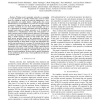Free Online Productivity Tools
i2Speak
i2Symbol
i2OCR
iTex2Img
iWeb2Print
iWeb2Shot
i2Type
iPdf2Split
iPdf2Merge
i2Bopomofo
i2Arabic
i2Style
i2Image
i2PDF
iLatex2Rtf
Sci2ools
INFOCOM
2008
IEEE
2008
IEEE
On Wireless Social Community Networks
—Wireless social community networks are emerging as a new alternative to provide wireless data access in urban areas. By relying on users in the network deployment, a wireless community can rapidly deploy a high-quality data access infrastructure in an inexpensive way. But, the coverage of such a network is limited by the set of access points deployed by the users. Currently, it is not clear if this paradigm can serve as a replacement of existing centralized networks operating in licensed bands (such as cellular networks) or if it should be considered as a complimentary service only. This question currently concerns many wireless network operators. In this paper, we study the dynamics of wireless social community networks using a simple analytical model. In this model, users choose their service provider based on the subscription fee and the offered coverage. We show how the evolution of social community networks depends on their initial coverage, the subscription fee, and the user p...
Communications | INFOCOM 2008 | Social Community | Social Community Networks | Wireless Social Community |
| Added | 31 May 2010 |
| Updated | 31 May 2010 |
| Type | Conference |
| Year | 2008 |
| Where | INFOCOM |
| Authors | Mohammad Hossein Manshaei, Julien Freudiger, Márk Félegyházi, Peter Marbach, Jean-Pierre Hubaux |
Comments (0)

